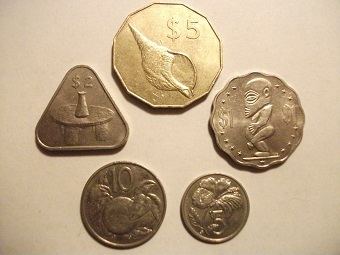Code CKD Symbol $ Banknotes $3, $10, $20, $50 | cent / tene c | |
 | ||
Coins 10, 20, 50 cents, $1, $2, $5 | ||
The dollar is the currency of the Cook Islands. The dollar is subdivided into 100 cents, although some 50 cent coins carry the denomination as "50 tene".
Contents
History
Until 1967, the New Zealand pound was used on the Cook Islands, when it was replaced by the New Zealand dollar. In 1972, coins were issued specifically for the Cook Islands, with banknotes appearing in 1987. The Cook Islands dollar is pegged at par to the New Zealand dollar. The currency of New Zealand and the Cook Islands circulate concurrently within the country.
Coins have been struck on different occasions mainly by the Royal Australian Mint, the Franklin Mint, and the Perth Mint with the paper currency being printed by De La Rue.
Coins
In 1972, bronze 1 and 2 cents, and cupro-nickel 5, 10, 20 and 50 cents, and 1-dollar coins were introduced. All were the same size, weight, and composition as the corresponding New Zealand coins, however, the unique crown-sized dollar coin circulated much more readily than its New Zealand equal. Each coin depicted plants, animals, and items unique to the Cook Islands.
In 1983, production of the 1 and 2-cent coins was ceased and the two coins were later demonetized.
In 1987, a smaller, lighter scallop-edged $1 coin with a similar size and shape to the Hong Kong $2 piece. This coin was issued to replace its bulky predecessor. Along with the new dollar, a triangular $2 coin and a dodecagonal (twelve-sided) $5 piece in equal size and shape to the Australian 50-cent coin were introduced, with the new $1 and $2 composed of cupro-nickel and the $5 coin in aluminium bronze.
2003 saw the reintroduction of a 1-cent coin, this time composed of aluminium rather than bronze and slightly smaller and thicker than the 10-cent piece. These were issued with five different reverses, each commemorating a few of the nation's historical themes.
A large, stainless steel 5 cent coin was issued in 2000 centered on FAO and depicting the Tangaroa image present on the dollar piece.
Cook Islands has a long reputation for frequent monetary oddities. It was one of the last countries to hold on to large crown-sized coins while elsewhere, coins of such size are seldom ever minted in large enough quantities intended for circulation. In 1987, with the release of its new $2 piece, Cook Islands officially became the first modern country to issue a circulating three-sided coin, as well as one of only a handful of countries at the time with a widely circulating $5 piece. 1988 brought the redesign of the 50-cent piece, quite unique in becoming the first coin in the country to bear a denomination name. Although widely recognized as "cents" this coin depicts "tene", the native language equivalent to the English word cent. It also abandoned its 1 and 2-cent pieces almost 10 years before both New Zealand and Australia, only to bring the 1 cent back 20 years later. It also replaced $1 and $2 notes for coins two years before New Zealand did, even though the Cook Islands dollar is pegged to the NZD at par. Amidst minting $2 and $5 coins, it also issued an oddball $3 note in between the dollar coins as part of the same series.
With the reduction in size of the New Zealand 10, 20 and 50-cent coins in 2006, older cent coins began to be phased out in both countries. However, $1, $2, and $5 pieces remained in use. Although a 2010 commemorative Cook Islands coin set in denominations 1, 2, 5, 10, 20, 50, cent and a bimetallic $1 have been minted with a similar size to some of the newer New Zealand ones, these coins appear to be collectors issues intended to raise money for the Cook Islands government rather than a true legal tender circulating coin set and it seems very unlikely that these will actually be found anywhere on the islands.
As part of a coinage reform, new coins were minted in 2015 by the Royal Australian Mint. The new coins carry similar designs to the older ones with the 10, 20, and 50 cents struck in nickel-plated steel, while the 1, 2, and 5 dollar coins are struck in aluminum bronze. The new 5 dollar coin features a traditional vaka instead of a conch. The cents are smaller than previous issues with closer size and weight to the current coins of New Zealand while the new dollars continue to have their distinctive shapes.
The obverse of all coins of the Cook Islands depict Queen Elizabeth II; she is Head of State and Queen of Cook Islands and New Zealand.
The reverse of standard issue coins are as depicts:
A large number of commemorative non circulating collectors coins are also issued by the Cook Islands featuring an almost endless array of themes as the government has a contract in which a coin design can be commissioned and minted with the name "Cook Islands" and dollar units for a fee, making coinage a resource for extra revenue. Due to exchange schemes involving large stocks of non-circulating commemorative coins, mintages are regulated and not recognized or accepted as legal tender within the Cook Islands.
